To build strong and toned legs, focus on major muscles like quads, hamstrings, glutes, and calves. Use compound exercises such as squats and lunges to enhance overall strength and efficiency. Combine these with isolation movements like leg curls and calf raises to target specific areas. Bodyweight exercises, like squats and glute bridges, and resistance band workouts are excellent for beginners and advanced athletes alike. Aim to work out your legs 2-3 times a week for the best muscle definition. Pre-exhaust techniques, such as leg curls before squats, help warm up your muscles and break through plateaus. Keep going to uncover more strategies.
Key Takeaways
- Focus on compound movements like squats and lunges to strengthen and tone multiple leg muscles simultaneously.
- Include lunge variations, such as reverse and walking lunges, for diverse and effective leg workouts.
- Perform deadlifts with proper technique to safely build strength in hamstrings, glutes, and lower back.
- Utilize bodyweight exercises like glute bridges and leg raises to sculpt legs without equipment.
- Incorporate resistance bands to target specific muscles and enhance leg strength and stability.
Major Leg Muscles
When you understand the major leg muscles, you can create more effective and targeted workouts for strength and toning.
First off, your quads are the front-and-center stars, helping with knee extension and stability.
Next, the hamstrings and glutes are the backstage crew, essential for any hip and thigh movements.
Don't forget the calves, those three amigos in your lower leg that keep you moving.
And let's give a shout-out to the adductors, the unsung heroes of thigh movements and overall leg strength.
Knowing these muscles isn't just for anatomy class; it's your ticket to leg-day glory.
Benefits of Leg Workouts
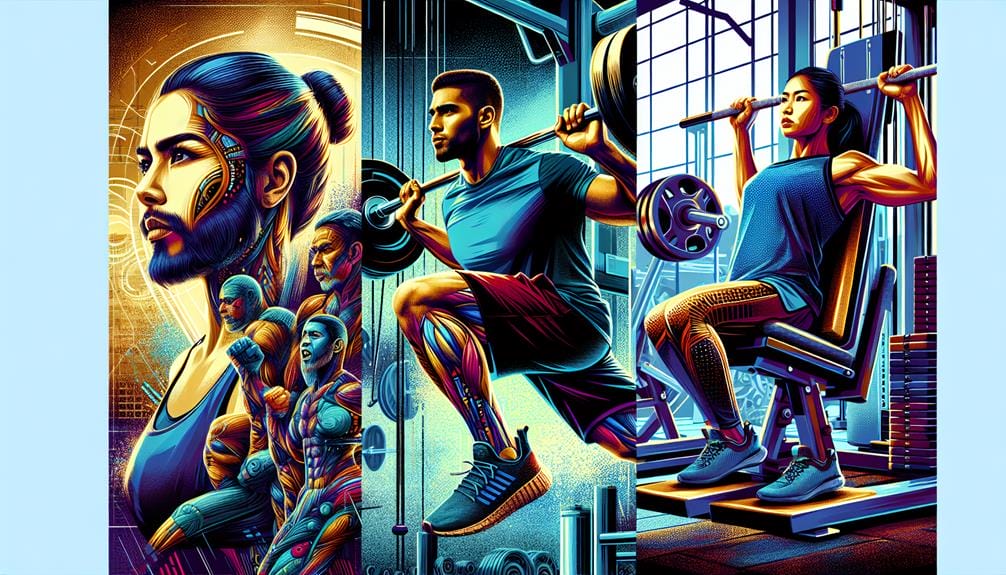
Leg workouts offer a range of benefits that go beyond just building muscle and strength. When you strengthen muscles in your legs, you're not just prepping for a bodybuilding contest; you're improving your agility and giving your lower body stability a much-needed boost. Plus, strong legs support your core, making you a more balanced, injury-proof individual.
Here's a quick rundown of the perks:
| Benefit | Description | Why It Matters |
|---|---|---|
| Strengthen Muscles | Essential for daily movements | Makes life easier |
| Improve Agility | Enhances balance and efficiency | Be nimble like a ninja |
| Prevent Injuries | Better stability means fewer falls | Keep yourself safe |
| Core Support | Strong legs bolster your core | Overall strength boost |
Effective Leg Workout
To make your leg workouts effective, prioritize compound movements like squats and lunges for overall strength and muscle growth.
Complement these with isolation exercises like leg curls and calf raises to target specific areas.
Aim for a consistent workout frequency, such as 2-3 times a week, to see significant improvements in muscle definition and endurance.
Compound Movements Importance
Compound movements are essential in an effective leg workout because they engage multiple muscle groups simultaneously, boosting efficiency. Think about it: why work one muscle when you can hit several? Squats, deadlifts, lunges, and step-ups not only save you time but also enhance functional strength, balance, and coordination. By incorporating these exercises into your leg workouts, you'll get better overall muscle development and performance. Plus, you'll burn more calories—who doesn't love that?
Here's a quick emotional table to pump you up:
| Exercise | Muscles Targeted | Fun Factor |
|---|---|---|
| Squats | Quads, Glutes | ���� |
| Deadlifts | Hamstrings, Back | ����️♂️ |
| Lunges | Quads, Glutes | ���� |
| Step-ups | Calves, Glutes | ���� |
Isolation Exercises Benefits
Isolation exercises guarantee targeted muscle engagement, essential for achieving balanced strength and symmetry in your leg workout. Think of them as the secret agents of fitness, stealthily working on muscle imbalances.
By honing in on specific muscles, you boost muscle activation, leading to muscle hypertrophy and improved muscle endurance.
These exercises are also your best buddy in rehab and injury prevention, targeting those weak or underdeveloped muscles that need extra TLC.
Imagine your legs as a symphony; isolation exercises make certain every instrument (read: muscle) is in perfect harmony, boosting overall muscle development.
Workout Frequency Tips
Balancing your leg workout with the right frequency is key to maximizing gains and preventing injuries. You should aim for 2-3 leg exercises sessions per week. This allows for proper rest and recovery, essential for muscle growth. Trust me, your lower body will thank you.
Overtraining can lead to fatigue and injuries, which are real buzzkills for your fitness routine. So, do yourself a favor and incorporate rest days between workouts. Think of it as giving your muscles a spa day—they need it!
If you're new to this leg workout game, seek advice from fitness pros to avoid rookie mistakes. Remember, workout frequency isn't a sprint; it's a marathon for those strong, toned legs.
Frequency of Leg Exercises
When planning your leg workouts, aim for 2-3 sessions per week to maximize muscle growth and recovery.
Balancing intensity with rest is key to preventing fatigue and injuries, so make sure you have rest days in between.
Using progressive overload techniques will help you gradually increase the challenge and enhance your lower body strength over time.
Optimal Workout Schedule
For best results and muscle growth, aim to incorporate leg exercises into your routine 2-3 times a week. This workout schedule gives you the perfect balance between muscle growth and avoiding the dreaded overtraining. Trust us, your legs need those rest days for muscle repair.
To keep things simple, follow this plan:
- Monday: Leg Day (Get ready to feel the burn)
- Wednesday: Rest Day (Netflix and ice packs)
- Friday: Leg Day (Round 2, let's go!)
- Weekend: Rest and recovery (You've earned it)
Fitness professionals agree that rest days are essential. Overtraining can lead to fatigue and injuries, which nobody wants. So, listen to your body and give those legs the downtime they deserve!
Balancing Intensity and Rest
To effectively build strength and prevent injuries, you should carefully balance the intensity of leg workouts with adequate rest periods. Leg exercises are essential, but overtraining can turn you into a wobbly mess faster than a toddler on roller skates.
Aim for leg workouts 2-3 times a week, allowing rest days in between for proper rest and recovery. Remember, muscle growth happens during rest, not while you're squatting like a champ.
Ignoring rest days can lead to fatigue and overuse injuries—no one wants to limp around like they've battled a feral shopping cart. So, take it easy, respect those rest days, and let your legs grow stronger and healthier.
Injury prevention is just as important as muscle gain!
Progressive Overload Techniques
While balancing intensity with rest is pivotal, progressively overloading your leg workouts promotes continuous muscle growth and strength gains. Incorporate leg exercises 2-3 times a week to give those muscles time for recovery.
Remember, no one wants to hobble around like a pirate with a peg leg due to overtraining. Proper rest days are key to avoiding injury and ensuring muscle recovery. You'll also maintain lower body stability while following a consistent workout schedule.
Here's a quick guide to keep things fun and effective:
- Schedule: Plan leg days with 48-hour gaps.
- Intensity: Gradually increase weights.
- Variety: Mix up exercises.
- Listen to Your Body: Rest if you feel fatigued.
Don't skip your rest days—they're essential!
Squats Variations
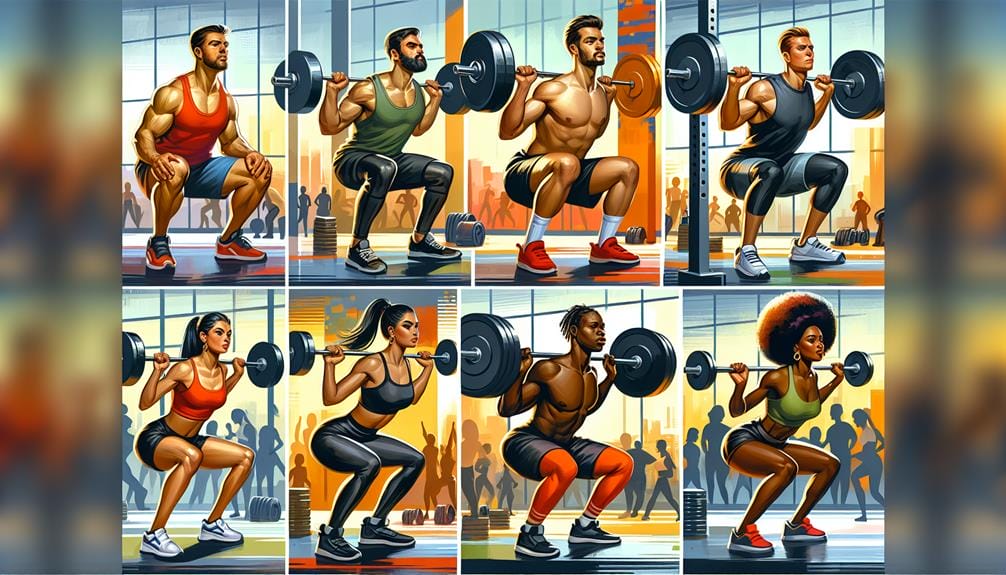
Explore various squats variations like goblet squats, sumo squats, and jump squats to effectively target different leg muscles. Goblet squats keep your core engaged while working your lower body. With sumo squats, you'll target those inner thighs and glutes, thanks to the wider stance. Jump squats? They're all about plyometric movements, increasing explosiveness and power in your legs.
Here's a quick table to break it down:
| Squat Type | Primary Target | Bonus Benefit |
|---|---|---|
| Goblet Squats | Lower Body | Core Engaged |
| Sumo Squats | Inner Thighs | Glutes |
| Jump Squats | Leg Muscles | Plyometric Power |
Lunges Variations
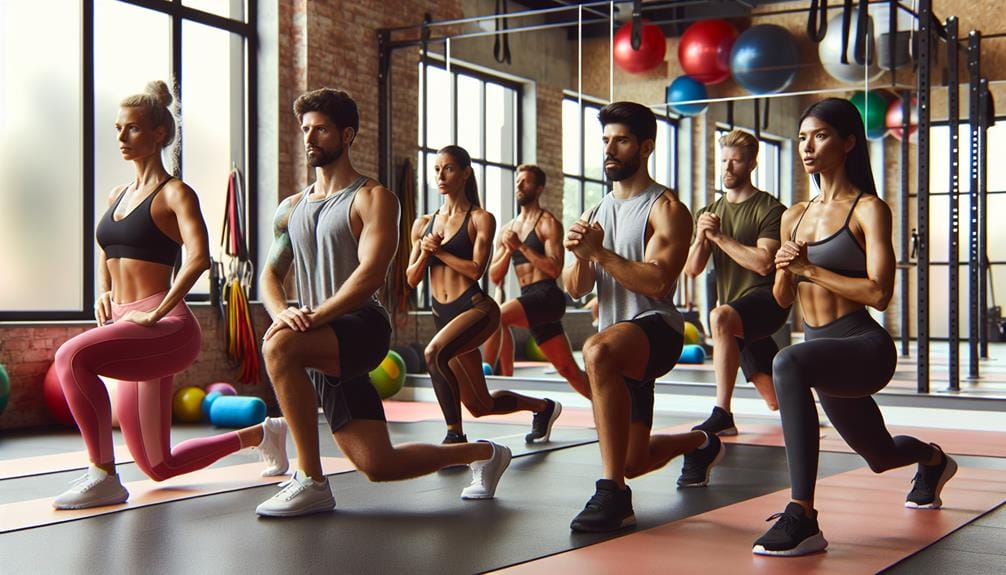
After mastering various squat techniques, it's time to focus on lunges to further enhance leg strength and definition. Lunges target your quads, hamstrings, and glutes, improving balance and endurance.
Plus, who doesn't want to look like they can conquer stairs two at a time? Here are some fun lunges variations to spice up your workout:
- Reverse Lunges: Step back instead of forward to really fire up those glutes.
- Walking Lunges: Great for endurance, but try not to trip over your own feet.
- Curtsy Lunges: Feel like royalty while working your inner thighs.
- Jumping Lunges: Perfect for a cardio boost, but maybe put away the breakables first.
Incorporate these variations to keep your leg days exciting and effective!
Deadlift Techniques
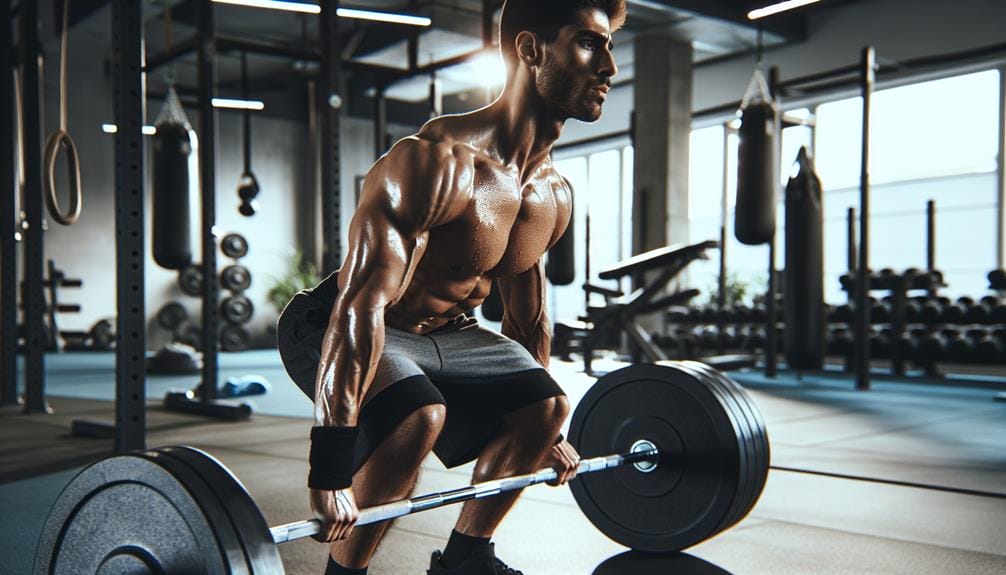
When performing deadlifts, you'll want to focus on maintaining proper form to maximize benefits and avoid injuries. Start by ensuring your spine stays neutral and your core is engaged to stabilize your lower back.
Additionally, be mindful of common mistakes like rounding your back or lifting with your arms rather than using your legs and hips.
Proper Form Tips
To guarantee you perform deadlifts safely and effectively, maintain a neutral spine by keeping your back flat and avoiding any rounding.
First, engage your core muscles to support your lower back—think of it as your built-in weight belt.
Second, push through your heels rather than your toes. This trick helps you activate your hamstrings and glutes, ensuring you're lifting like a pro.
Third, keep the bar close to your body as you lift; no need to play keep-away with your shins.
Finally, avoid locking your knees at the top. Instead, maintain muscle tension to prevent hyperextension and keep those legs working hard.
Common Mistakes Avoided
Many lifters make the mistake of rounding their back, which can lead to serious injury and diminish the effectiveness of the deadlift. Don't let your back turn into a sad rainbow! Keep it flat to maximize muscle engagement and avoid back injuries.
Another common mistake: lifting with your arms instead of your legs. Remember, this is a leg workout, not an arm-wrestling contest. Engage your core and use proper technique to generate power from your legs for strong legs.
Lastly, don't forget to keep your gaze forward to maintain proper deadlift form. By avoiding these common mistakes, you'll master the deadlift and build those strong and toned legs you've been dreaming of.
Bodyweight Leg Exercises
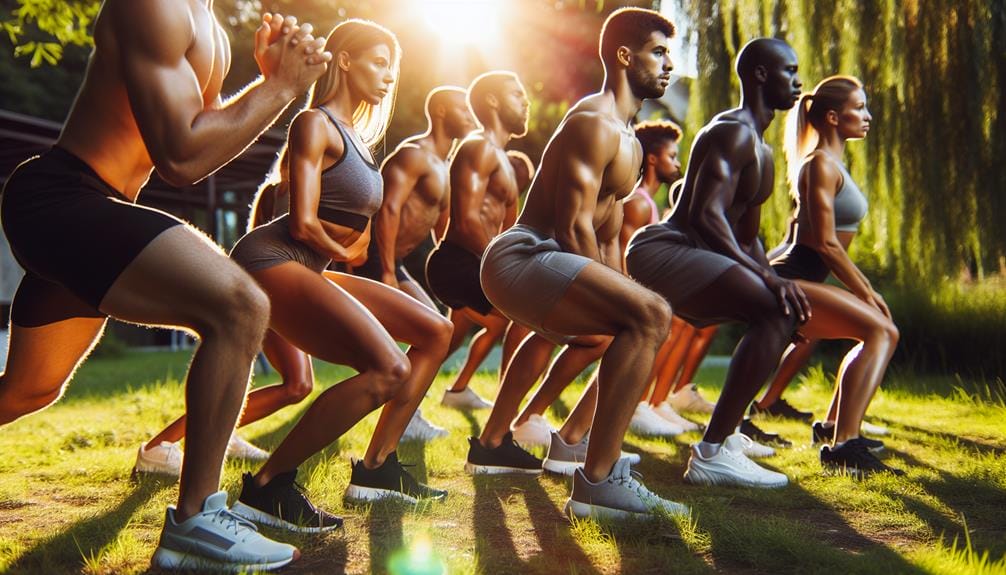
Bodyweight leg exercises offer a powerful way to build strength and endurance without any equipment. These exercises target your quads, hamstrings, glutes, and calves, sculpting your lower body into a masterpiece. Plus, they're perfect for any setting, whether you're at home, in the park, or awkwardly trying to avoid eye contact at the gym.
Here are four must-try exercises:
- Squats: Feel the burn in your quads and glutes as you lower and lift.
- Lunges: Give those hamstrings and calves a good workout while improving balance.
- Glute Bridges: Perfect for targeting your glutes and hamstrings while lying down.
- Leg Raises: Engage your core and calves as you lift those legs sky-high.
Get moving and watch those legs transform!
Resistance Band Leg Workouts
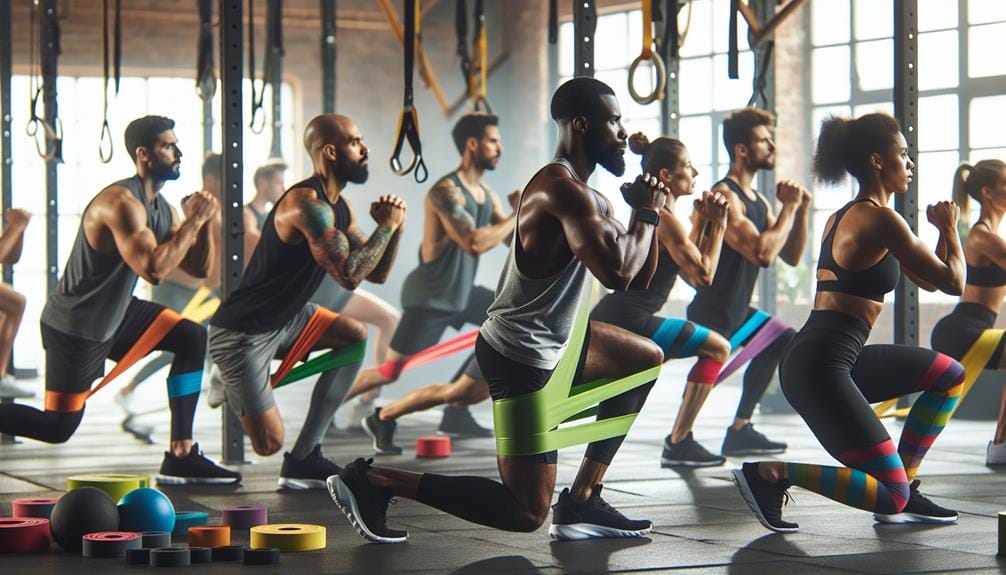
Resistance band leg workouts offer a versatile and efficient way to target your lower body muscles, enhancing strength, tone, and stability. These exercises work your glutes, hamstrings, and quads, providing constant tension to boost muscle strength and improve balance. Plus, they're perfect for all fitness levels—no gym required!
Here's a quick guide to some effective moves:
| Exercise | Target Area |
|---|---|
| Fire Hydrants | Glutes |
| Glute Kickbacks | Hamstrings |
| Squats with Bands | Quads |
Try adding these resistance band leg exercises to your routine to see gains in muscle strength and stability. They're so effective, your legs might just start auditioning for a superhero role!
Pre-Exhaust Techniques
Pre-exhaust techniques can transform your leg workouts by targeting specific muscles with isolation exercises before diving into compound movements. Think of it as giving your muscles a wake-up call before the main event.
You'll start with exercises like leg curls or straight-leg deadlifts to boost muscle activation, then move on to compound moves like the leg press or Smith machine half-squats. Here's a quick roadmap:
- Leg Curls: Warm up those hamstrings.
- Straight-Leg Deadlifts: Engage your posterior chain.
- Butt Blasters: Fire up the glutes.
- Smith Machine Half-Squats: Finish strong with quads and glutes.
Pre-exhaust techniques help you break through plateaus and maximize your gains. Plus, who doesn't want legs that could rival a superhero's?
Proper Form and Safety

Mastering proper form in leg exercises is crucial for maximizing results and preventing injuries. Think of yourself as a sculptor—only, your chisel is proper form and safety.
Align your body correctly during squats, lunges, and deadlifts to avoid turning your workout into a slapstick comedy. Use controlled movements to guarantee each rep counts.
Don't forget the basics: warm-up, use appropriate weights, and, if you're unsure, seek guidance from a fitness pro.
Nail the mechanics and execution techniques to hit your fitness goals without sprains or strains. Remember, it's not just about lifting heavy but lifting right. Your legs (and dignity) will thank you!
Conclusion
Incorporating leg workouts into your fitness routine can dramatically improve your overall strength and endurance.
Did you know that squats activate nearly 200 muscles? That's a compelling reason to include them in your regimen.
Remember, a balanced approach with squats, bodyweight exercises, and resistance band workouts will help you build strong and toned legs.
By maintaining proper form and following a consistent schedule, you'll see significant improvements in no time.
Prioritize safety to maximize results and prevent injuries.
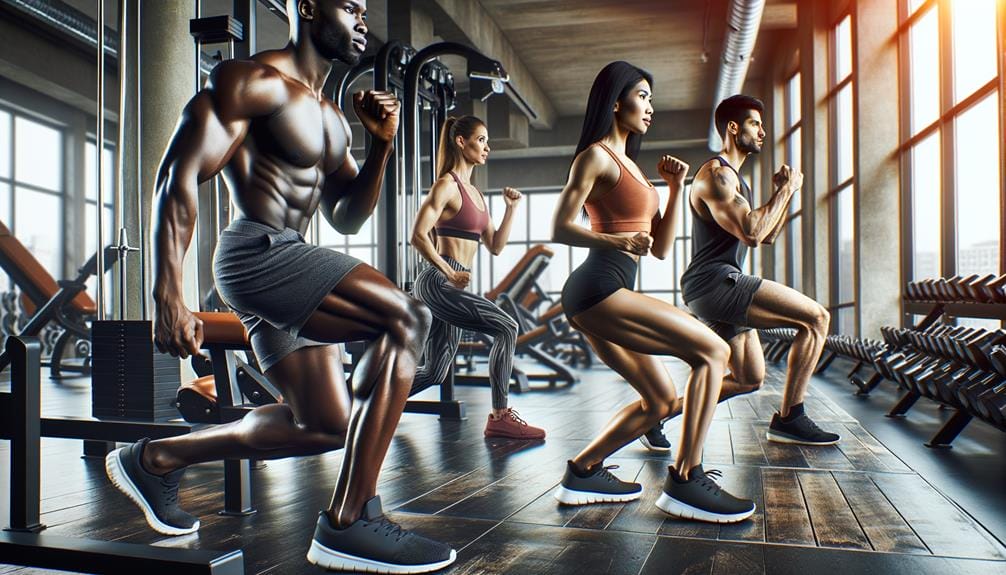

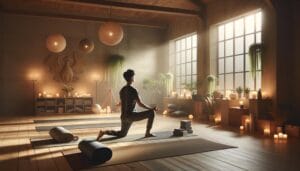





Leave a Comment